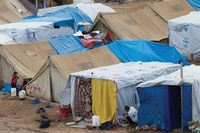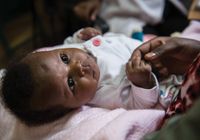
Photo credits: UNICEF/NYHQ2014-1932/Anmar
Working with governmental, humanitarian and development partners in productive, cooperative partnerships is critical to a practical and comprehensive humanitarian response. When a crisis warranting a response occurs, humanitarian agencies immediately establish a coordination system to facilitate cooperation and avoid duplication of efforts. This coordination system is based on an internationally agreed framework that includes designated lead agencies, in collaboration with the relevant government agencies, to coordinate each sector of humanitarian action.[1] For example, WHOabbreviation and the Ministry of Health lead the health sector/cluster, and UNICEFabbreviation and the Ministry of Health lead the nutrition sector/cluster. WHOabbreviation and the Ministry of Health, as heads of the health sector/cluster, are ultimately accountable for ensuring the provision of newborn care.
At the beginning of a humanitarian response, the health sector/cluster should identify an organization to lead the SRHabbreviation, including MNHabbreviation, response. This can be any national or international NGO or UNabbreviation agency that has the capacity to effectively lead the SRMNH response in collaboration with the Ministry of Health. The nominated agency immediately dedicates a fulltime SRHabbreviation coordinator for a minimum of three to six months to provide operational and technical support to the health partners. This coordinator convenes the SRHabbreviation working group, operating under the health cluster/sector, and facilitates coordinated planning to ensure the prioritization of SRHabbreviation care and effective provision of MISPabbreviation services.
- If the health cluster/sector does not identify a lead agency for the SRMNH response, raise this issue in a health sector/cluster meetinginfo and advocate for the establishment of a SRHabbreviation working group under a lead agency.
Box 4.1: Engaging local and international development partners
Establishing respectful partnerships with development agencies that were working in-country before the crisis is important for an effective response. These agencies can include international, national and community-based organizations, women’s groups, faith-based agencies, and other advocacy and service delivery organizations working on MNHabbreviation. Partnering with development actors is useful because they can provide deeper understanding of the local context and culture, which can help inform the design of a more appropriate response. These agencies can also help identify pre-existing resources and capacities, and provide insights into which communities are most in need of assistance. Development agencies may not be familiar with the humanitarian coordination system. When feasible, support these organizations, particularly local groups, to meaningfully participate in the SRHabbreviation working group meetings. Linking with the national ENAPabbreviation, where in place, may also be useful.
4.1.1 Incorporate questions about newborn health services within a rapid health assessment
At the onset of a humanitarian response, the health sector/cluster will undertake RHAabbreviation. In addition to assessing service availability, the health sector/cluster’s RHAabbreviation provides an estimation of the population needing services, thus forming the basis for service development and implementation. For this reason, integrating questions into the health sector/cluster’s RHAabbreviation about newborn health care and about the population requiring newborn health services is critical (Box 4.3).
- Work with the health sector/cluster to ensure that the RHAabbreviation includes these questions and basic population estimates. For example, ensure that MNHabbreviation-related figures included in the RHAabbreviation comprise:
- the total population prior to the crisis;
- the total number of the affected population;
- the number of women of childbearing age, pregnant women and newborns within this population; the number of deliveries per month;
- demographic indicators about the MNHabbreviation status of the affected population prior to the crisis such as the maternal and newborn mortality ratios, stillbirth rates, the total fertility rate, crude birth rate, contraceptive prevalence, and percentage of births with a skilled attendant and/or facility-based births.[2]
- Pre-crisis MDPSR data (if possible and available)
- Pre-crisis country ENAPabbreviation/SRMNCAHabbreviation plans (if possible and available)
- Review the RHAabbreviation to ensure that the assessment process is gender sensitive, involving men and women from the affected community as assessors and translators whenever possible. This ensures that information collected is accurate, up-to-date and actionable, and that acceptance and ownership of the assessment results are maximized.
4.1.2 Advocate for the inclusion and prioritisation of newborn health in humanitarian response plans
Although newborn health services are part of the MISP, humanitarian health actors may not prioritize them. Advocacy and inter-agency coordination are key to ensuring that newborn health is adequately addressed.
- Participate in the SRHabbreviation working group meetings and, where necessary, advocate to include newborn care issues (integrated with maternal health) on the agenda.
- Work with the SRHabbreviation coordinator to task the working group with identifying priority newborn health services and coordinating with the broader group of governmental, development and humanitarian responders in the country to ensure that MNHabbreviation services are integrated into the humanitarian response.
- Determine which government ministries, UNabbreviation agencies, INGOs and local NGOs are working in SRHabbreviation care: these agencies and staff will be essential partners to advocate and integrate newborn health services within the humanitarian response (Box 4.1).
- Ensure government and other partners are appropriately vetted to establish legitimacy.
- Identify and engage government programs and international and local initiatives that pre-date the crisis, as well as humanitarian agencies that enter at the onset of, or immediately after, a crisis response.
Box 4.2: Leveraging the field guide to improve newborn care practices in South Sudan
In 2016, interagency partners monitored the rollout of the Field Guide in South Sudan and, after six months, held a newborn health technical workshop to share lessons learned and generate feedback on how to address bottlenecks to service delivery. The workshop was co-hosted by the Ministry of Health and UNICEFabbreviation, and the SRHabbreviation Working Group members as well as other humanitarian and development actors were invited. By bringing together key partners from across the development-humanitarian continuum and ensuring leadership by the government, the workshop helped facilitate the development of a Every Newborn Action Plan (ENAP) for the country. South Sudan’s ENAPabbreviation has led to the development of a newborn service package under the main health funding mechanism in the country. The National Community Health Strategy has also been revised to incorporate community-based newborn interventions.
Note: For further information, please see Sami S, Amsalu R, Dimiti A, et al,. An analytic perspective of a mixed methods study during humanitarian crises in South Sudan: translating facility- and community-based newborn guidelines into practice. Conflict and Health. 2021. doi: 10.1186/s13031-021-00339-8

